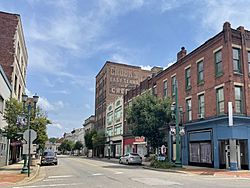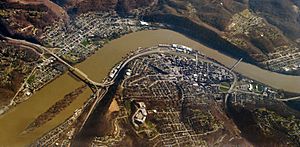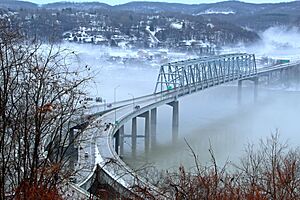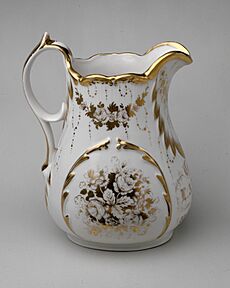East Liverpool, Ohio facts for kids
Quick facts for kids
East Liverpool, Ohio
|
|
|---|---|

East Fifth Street Historic District
|
|
| Nickname(s):
Pottery Capital of the World, Crockery City
|
|
| Motto(s):
"We're Open for Business"
|
|

Location of East Liverpool in Columbiana County, Ohio.
|
|
| Country | United States |
| State | Ohio |
| County | Columbiana |
| Founded | 1802 |
| Named for | Liverpool, England |
| Government | |
| • Type | Mayor–council |
| Area | |
| • Total | 4.90 sq mi (12.68 km2) |
| • Land | 4.70 sq mi (12.18 km2) |
| • Water | 0.20 sq mi (0.51 km2) |
| Elevation | 965 ft (294 m) |
| Population
(2020)
|
|
| • Total | 9,958 |
| • Estimate
(2023)
|
9,705 |
| • Density | 2,118.27/sq mi (817.86/km2) |
| Time zone | UTC−5 (Eastern (EST)) |
| • Summer (DST) | UTC−4 (EDT) |
| ZIP code |
43920
|
| Area code | 330, 234 |
| FIPS code | 39-23730 |
| GNIS feature ID | 1085891 |
| School District | East Liverpool City SD |
| Website | http://www.eastliverpool.com/ |
East Liverpool is a city in southeastern Columbiana County, Ohio, United States. In 2020, about 9,958 people lived there. It sits along the Ohio River, where Ohio, Pennsylvania, and West Virginia meet. It's about 30 miles (48 km) from both Pittsburgh and Youngstown. The city is famous for its pottery industry, which was once the biggest in the United States.
Contents
History of East Liverpool
Long ago, Native American groups like the Mingo, Lenape, and Wyandot lived in the area. You can still find ancient rock carvings, called petroglyphs, nearby.
East Liverpool started in 1798 when an Irish immigrant named Thomas Fawcett bought land along the Ohio River. In 1802, he planned out a town called St. Clair. It was later called Fawcettstown, then Liverpool in 1816, named after Liverpool, England. The postal service added "East" to the name to avoid confusion with another "Liverpool" in Ohio.
In its early years, the town grew with mills, stores, and docks. The first school opened in 1820. In 1834, Liverpool officially became East Liverpool.
The Rise of Pottery
The city's biggest change happened in 1839 when an English potter named James Bennett arrived. He started the first pottery factory, which began East Liverpool's most important industry. Many people from Western Europe, especially England, moved here to work in the potteries. By 1880, East Liverpool was the largest city in its county.
In the 1960s, parts of downtown East Liverpool were changed to build a new highway. The city's population reached its highest point in 1970, with over 26,000 people. However, the pottery industry started to slow down in the mid-1960s. Many jobs were lost as pottery production moved to other countries where it was cheaper to make. This caused many people to leave the area to find work.
Environmental Concerns and Improvements
In 1963, a factory that burned toxic waste was built in East Liverpool. Some people hoped it would bring new jobs as the pottery industry declined. Later, people worried about harmful particles, like manganese, affecting the health of residents. Studies showed that people in East Liverpool had higher levels of certain metals in their blood.
Community groups worked with government agencies to reduce these harmful elements. From 2006 to 2013, the air quality improved. Even though there were some increases in harmful particles in 2014, people continued to work hard to make the environment safer.
Downtown Revitalization
In the mid-1990s, the city worked to make its downtown area better. They added old-fashioned streetlights, created a new central area called Devon's Diamond, and rebuilt the old high school's clock tower. In 2010, East Liverpool was no longer the largest city in the county, with Salem taking its place.
Pottery Industry
East Liverpool became the main center in the United States for making ceramic toilets and tableware. At one point, 85 different companies were operating here, making two-thirds of the country's pottery between 1880 and 1950. The pottery area included East Liverpool and nearby towns like Wellsville, Ohio, and Chester and Newell, West Virginia, across the Ohio River.
In 1887, East Liverpool had 21 large pottery factories with over 2,500 workers. By 1923, there were 17 companies with 7,000 employees.
James Bennett from England started the industry in 1839. He used the good transportation routes and rich local clays. Soon, East Liverpool was known as "The Crockery City." Many potters from England moved to East Liverpool because of better wages and the chance to own land. By 1879, almost all 24 pottery factories were run by English immigrants. Until 1900, about 85% of the people living in East Liverpool had English family roots.
Some of the biggest pottery companies included Knowles, Taylor & Knowles; Taylor, Smith & Taylor; The Hall China Company; and Homer Laughlin China Company.
Today, two pottery companies still operate in the area: American Mug & Stein Company and the Fiesta Tableware Company (formerly Homer Laughlin). East Liverpool also made most of the "yellowware" pottery used in the U.S. in the mid-1800s. One of the most famous ceramics was "Lotus Ware," made by Knowles, Taylor & Knowles in the 1890s. It won awards at the 1893 World's Fair in Chicago. The Museum of Ceramics in downtown East Liverpool has the largest public collection of Lotus Ware.
The children's novel Doll Bones by Holly Black is set in East Liverpool because of its rich pottery history.
Geography

East Liverpool covers about 4.76 square miles (12.33 sq km). Most of this is land, with a small amount of water.
The city has several neighborhoods, including:
- Beechwood
- Downtown
- East End
- Fisher Park
- Klondyke
- Pleasant Heights
- Thompson
- West End
- Sunnyside
- Jethro
Population Information
| Historical population | |||
|---|---|---|---|
| Census | Pop. | %± | |
| 1830 | 136 | — | |
| 1840 | 503 | 269.9% | |
| 1850 | 987 | 96.2% | |
| 1860 | 1,308 | 32.5% | |
| 1870 | 2,105 | 60.9% | |
| 1880 | 5,568 | 164.5% | |
| 1890 | 10,956 | 96.8% | |
| 1900 | 16,485 | 50.5% | |
| 1910 | 20,387 | 23.7% | |
| 1920 | 21,411 | 5.0% | |
| 1930 | 23,329 | 9.0% | |
| 1940 | 23,555 | 1.0% | |
| 1950 | 24,217 | 2.8% | |
| 1960 | 22,306 | −7.9% | |
| 1970 | 26,243 | 17.6% | |
| 1980 | 16,517 | −37.1% | |
| 1990 | 13,654 | −17.3% | |
| 2000 | 13,089 | −4.1% | |
| 2010 | 11,195 | −14.5% | |
| 2020 | 9,958 | −11.0% | |
| 2023 (est.) | 9,705 | −13.3% | |
| Sources: | |||
In 2010, there were 11,195 people living in East Liverpool. About 91.7% of the people were White, and 4.6% were African American. About 1.1% were Hispanic or Latino.
The average age in the city was 37.6 years old. About 25.4% of residents were under 18, and 14.6% were 65 or older.
Arts and Culture

Since 1970, East Liverpool has hosted the annual Tri-State Pottery Festival in June. This festival celebrates the local ceramics industry with pottery displays, games, rides, food, and live entertainment. Also, the First Fridays on Fifth event series happens from May to October, featuring local crafts, music, and food.
Carnegie Public Library
The Carnegie Public Library was built with money from Andrew Carnegie, a famous businessman and giver. His uncle lived in East Liverpool. This library was one of the first Carnegie libraries in Ohio. It opened on May 8, 1902, and has been updated twice since then.
Historic Places to Visit

East Liverpool has many historic buildings and areas. Sixteen properties and three historic districts are listed on the National Register of Historic Places. This includes the Beginning Point of the U.S. Public Land Survey, which is a special national landmark.
The Diamond Historic District has buildings from 1884. The East Fifth Street Historic District shows examples of beautiful Neoclassical architecture. The East Liverpool Downtown Historic District covers the whole downtown area and is known for its Italianate and Second Empire architecture.
Many historic homes belonged to important business owners from the late 1800s. These include the Cassius Clark Thompson House (1876) and the Homer Laughlin House (1882). Other important historic buildings include the original East Liverpool Post Office (1909), the Public Library (1902), and the Odd Fellows Temple (1907).
Parks and Recreation
East Liverpool has two public parks. Thompson Park was created in 1899 when composer Will Lamartine Thompson gave 100 acres of land to the city. It opened in 1900 as a green space away from the busy factories. Today, it has picnic areas, a swimming pool, sports fields, a disc golf course, a playground, and walking trails. The Broadway Wharf on the Ohio River also has a small park and a place to launch boats.
The Lewis and Clark National Historic Trail, which follows the path of the famous Lewis and Clark Expedition, goes through East Liverpool.
Sports
East Liverpool once had semiprofessional sports teams. The East Liverpool Potters basketball team played from 1906 to 1909. A minor league baseball team also called the East Liverpool Potters played from 1906 to 1912. The East Liverpool Country Club has a 9-hole golf course that opened in 1921.
Education
Schools for Kids and Teens
Children in East Liverpool attend public schools run by the East Liverpool City School District. The schools are La Croft Elementary (grades K-4), North Elementary (grades K-4), Westgate Middle School (grades 5-6), and East Liverpool Junior/Senior High School (grades 7-12).
There are also private schools like East Liverpool Christian School (K-12) and Lincoln Park Performing Arts Charter School (7-12). Two online schools, Buckeye Online School for Success and Quaker Digital Academy, also operate downtown.
Colleges and Training
Kent State University has a campus in East Liverpool that opened in 1965. Together with the Kent State Salem campus, they offer more than 20 different degrees. The New Castle School of Trades also opened a campus downtown in 2016.
Media
East Liverpool used to have several newspapers. Most of them combined into The Review, which now serves the southern part of Columbiana County. The Morning Journal from Lisbon also reports on the area.
The radio station WOHI 1490 AM has been broadcasting from the city since 1949. It plays classic hits.
Transportation

Highways
Several highways pass through East Liverpool, making it easy to travel to and from the city:
Bridges
Since the 1890s, East Liverpool has been connected to Chester and Newell in West Virginia by bridges over the Ohio River.
- Chester Bridge (1896–1969) – This was the first bridge to carry U.S. Route 30. It connected East Liverpool with Chester and was taken down in 1970.
- Newell Bridge (1905–present) – This bridge connects East Liverpool to West Virginia State Route 2. It is the only privately owned toll bridge on the Ohio River.
- Jennings Randolph Bridge (1977–present) – This bridge replaced the old Chester Bridge. It connects East Liverpool and Chester and carries Route 30 over the river. It is named after Jennings Randolph, a politician from West Virginia.
Notable People
Many interesting people have come from East Liverpool, including:
- Dan Adkins, a comic book artist for Marvel Comics
- Bernie Allen, a former Major League Baseball player
- John Caparulo, a stand-up comedian
- Jane Louise Curry, an author of children's novels
- Lou Holtz, a famous football coach and TV commentator
- O. O. McIntyre, a well-known newspaper columnist
- Hy Myers, a former Major League Baseball player for the Brooklyn Dodgers
- Ruth Crawford Seeger, a composer and the first woman to win a special fellowship called the Guggenheim Fellowship
- Will Lamartine Thompson, a composer of hymns and gospel music
- Norm Van Lier, a former National Basketball Association (NBA) basketball player
Sister Cities
East Liverpool has one sister city:
 Stoke-on-Trent, England, United Kingdom
Stoke-on-Trent, England, United Kingdom
See also
 In Spanish: East Liverpool (Ohio) para niños
In Spanish: East Liverpool (Ohio) para niños






